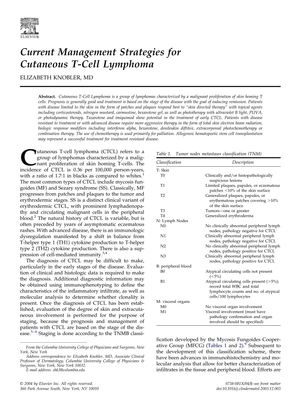Current Management Strategies for Cutaneous T-Cell Lymphoma
May 2004
in “
Clinics in Dermatology
”
cutaneous T-cell lymphoma CTCL corticosteroids nitrogen mustard bexarotene gel phototherapy UVB light PUVA photodynamic therapy total skin electron beam radiation interferon alpha denileukin diftitox extracorporeal photochemotherapy allogeneic hematopoietic stem cell transplantation bexarotene refractory stage IA-IIA disease complete remission combination therapies allogeneic HSCT CTCL bexarotene UVB PUVA phototherapy total skin electron beam radiation interferon alpha extracorporeal photochemotherapy allogeneic HSCT

TLDR The document concludes that treatment for cutaneous T-cell lymphoma should be customized to each patient's disease stage, balancing benefits and side effects, with no cure but many patients living long lives.
In May 2004, a document outlined the treatment strategies for cutaneous T-cell lymphoma (CTCL), a skin-involved lymphoma with generally good prognosis. Early-stage CTCL treatments included topical agents like corticosteroids, nitrogen mustard, and bexarotene gel, as well as phototherapy with UVB light, PUVA, or photodynamic therapy. Advanced CTCL required more aggressive treatments such as total skin electron beam radiation, interferon alpha, denileukin diftitox, extracorporeal photochemotherapy, and potentially allogeneic hematopoietic stem cell transplantation. The document highlighted the importance of tailoring treatment to the disease stage and individual patient, with a focus on balancing treatment toxicity against benefits. It also noted that while there is no cure for CTCL, many patients have a long life expectancy. Specific treatments like bexarotene showed a 54% response rate for refractory stage IA-IIA disease, and interferon alpha achieved a 41% complete remission in a long-term study. Side effects were discussed for each treatment, and the need for individualized treatment plans was emphasized due to the potential for relapse and the varying response rates. Combination therapies and the potential of allogeneic HSCT for refractory cases were also mentioned, although further studies were needed to confirm their effectiveness.

